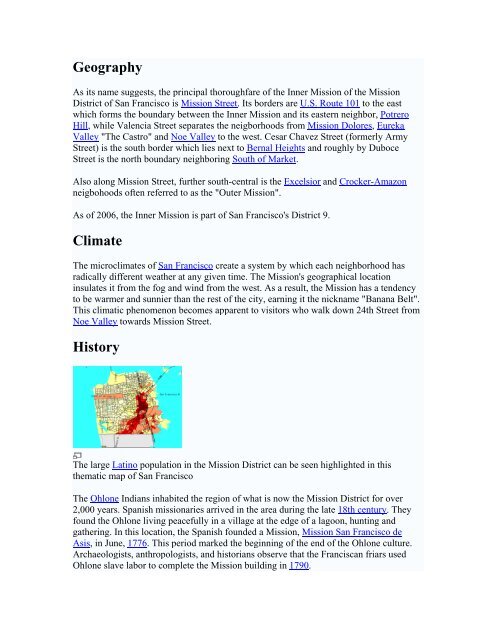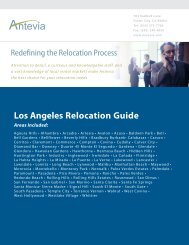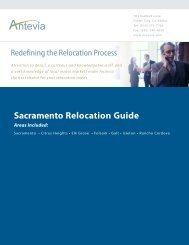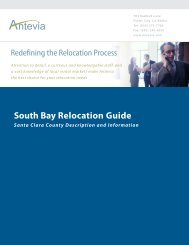San Francisco Relocation Guide - Antevia
San Francisco Relocation Guide - Antevia
San Francisco Relocation Guide - Antevia
You also want an ePaper? Increase the reach of your titles
YUMPU automatically turns print PDFs into web optimized ePapers that Google loves.
Geography<br />
As its name suggests, the principal thoroughfare of the Inner Mission of the Mission<br />
District of <strong>San</strong> <strong>Francisco</strong> is Mission Street. Its borders are U.S. Route 101 to the east<br />
which forms the boundary between the Inner Mission and its eastern neighbor, Potrero<br />
Hill, while Valencia Street separates the neigborhoods from Mission Dolores, Eureka<br />
Valley "The Castro" and Noe Valley to the west. Cesar Chavez Street (formerly Army<br />
Street) is the south border which lies next to Bernal Heights and roughly by Duboce<br />
Street is the north boundary neighboring South of Market.<br />
Also along Mission Street, further south-central is the Excelsior and Crocker-Amazon<br />
neigbohoods often referred to as the "Outer Mission".<br />
As of 2006, the Inner Mission is part of <strong>San</strong> <strong>Francisco</strong>'s District 9.<br />
Climate<br />
The microclimates of <strong>San</strong> <strong>Francisco</strong> create a system by which each neighborhood has<br />
radically different weather at any given time. The Mission's geographical location<br />
insulates it from the fog and wind from the west. As a result, the Mission has a tendency<br />
to be warmer and sunnier than the rest of the city, earning it the nickname "Banana Belt".<br />
This climatic phenomenon becomes apparent to visitors who walk down 24th Street from<br />
Noe Valley towards Mission Street.<br />
History<br />
The large Latino population in the Mission District can be seen highlighted in this<br />
thematic map of <strong>San</strong> <strong>Francisco</strong><br />
The Ohlone Indians inhabited the region of what is now the Mission District for over<br />
2,000 years. Spanish missionaries arrived in the area during the late 18th century. They<br />
found the Ohlone living peacefully in a village at the edge of a lagoon, hunting and<br />
gathering. In this location, the Spanish founded a Mission, Mission <strong>San</strong> <strong>Francisco</strong> de<br />
Asis, in June, 1776. This period marked the beginning of the end of the Ohlone culture.<br />
Archaeologists, anthropologists, and historians observe that the Franciscan friars used<br />
Ohlone slave labor to complete the Mission building in 1790.







